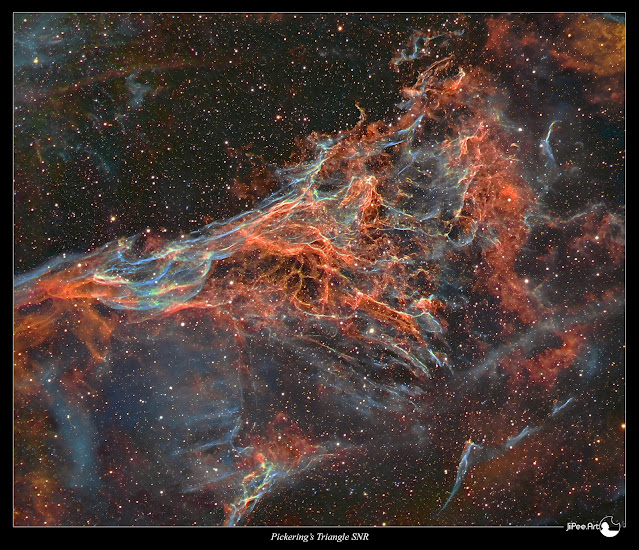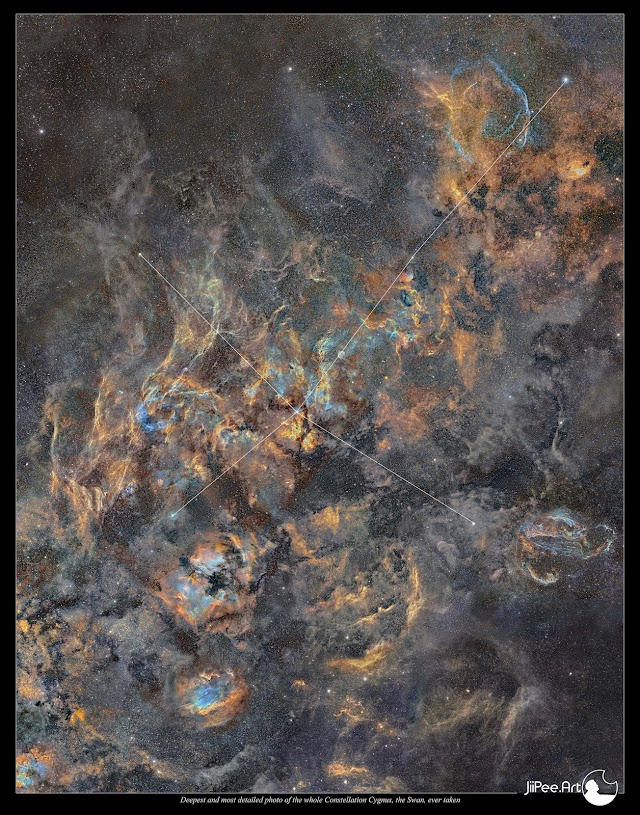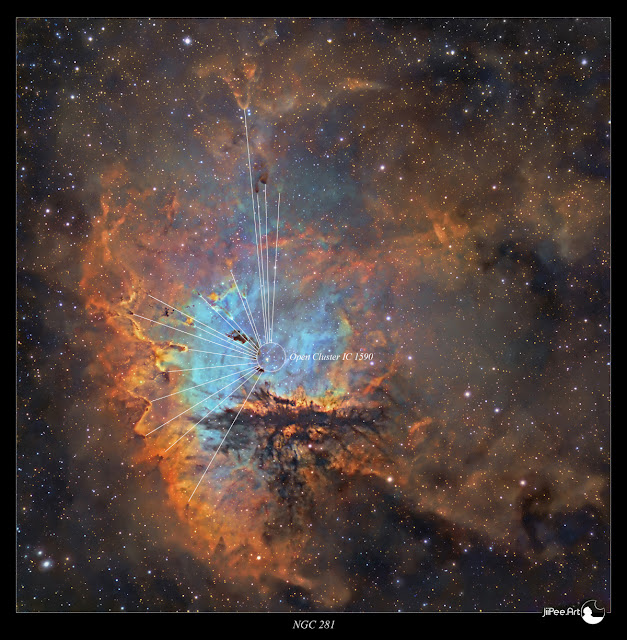COPYRIGHT, PLEASE NOTE
Tuesday, April 8, 2025
A two Frame Panorama of IC 1805, the Heart Nebula
I just published an image of the unnamed pillar-like formation inside the Heart Nebula.
I've created a two-frame mosaic from the new photo, showing its relation to Melotte 15 at the center of the Heart Nebula.
As is usually the case, these pillar-like formations point toward the source of ionization. When radiation pressure (solar wind) push gas and dust away from a newborn star cluster, denser regions of gas can resist this force and begin to collapse. This process leads to the formation of the pillar-like structures. The tips of these pillars can become the birthplace of a second generation of stars within the nebula.
A Hidden Pillar and Melotte 15 in IC 1805, the Heart Nebula
Click for a large image, 3000 x 1700 pixels.


Technical Details and other info can be seen in this blog post
Unnamed Pillar Formation

Technical Details and other info can be seen in this blog post
Strange Pillar like Formation in IC 1805, The Heart Nebula
This is an object in the Heart Nebula that I have captured from time to time. My previous photo was taken in 2012.
This new photo reveals more details, even though the exposure time for H-alpha light was only 5 hours.
The pillar-like formations are typically pointing toward a source of ionization, in this case, the more famous Melotte 15.
I haven't been able to find a name for this beautiful object
 A mapped color image from a light emitted by an ionized elements, sulfur=red, hydrogen=green and oxygen=blue. Original resolution 6500 x 6500 pixels
A mapped color image from a light emitted by an ionized elements, sulfur=red, hydrogen=green and oxygen=blue. Original resolution 6500 x 6500 pixelsO-III, 6x 1200 s, binned 2x2 = 2h
Wednesday, March 26, 2025
Soul Nebula, IC1848
Click for a large image, 2000 x 2000 pixels

Click for a large image, 2000 x 2300 pixels
Click for a large image, 4600 x 2000 pixels
Hearth and Soul Nebulae at upper right corner
O-III, 6x 1200 s, binned 2x2 = 2h
Monday, March 24, 2025
Melotte 15 in heart nebula, IC 1805
I shot material for this new photo back in February, 10 hours of exposures total for three narrowband color channels. (H-alpha, O-III and S-II)
Click for a large image, 2000 x 2000 pixels
Click for a large image, 2500 x 3200 pixels
O-III, 6x 1200 s, binned 2x2 = 2h
Monday, March 17, 2025
HFG1, a Planetary Nebula in Cassiopeia
I managed to get 17 hours of H-alpha light for the HFG1 and now I'm able to do color photo out of it.
This is a difficult target, very diffused and large, I tried to keep my processing kind of modest to bring out delectate nature of an old and dim planetary Nebula.
Total exposure time is 37 hours and signal wasn't the best possible but I'm happy with this result.
HFG1 in O-III light only
Click for a large image, 2000x2000 pixels
H-alpha, 51 x 1200 s = 17h
Saturday, March 8, 2025
NGC 281, a New Revision
I made a new composition out of my new NGC 281 material, the original composition and technical details can be seen here: https://astroanarchy.blogspot.com/2025/01/new-photo-of-ngc-281.html
This new poster format composition brings out the dynamic nature of this target better.
Click for a large image, 2000x2600 pixels
Thursday, March 6, 2025
A Very Deep View to my Soul, IC1848
This is a new photo of the Soul Nebula in Cassiopeia.
A total of 20 hours of H-alpha exposure, along with 6 hours of S-II and O-III combined, allows me to capture intricate details of this relatively bright astronomical cloud of gas and dust.
Click for a large image, 2100x2300 pixels
sulfur=red, hydrogen=green and oxygen=blue
Click for a full size, 2100x2300 pixels
O-III,21x 1200 s, binned 2x2 = 3h
A single calibrated 20 min exposure of H-alpha, Bin 1x1
Tuesday, March 4, 2025
HFG1, a Challenging Planetary in Cassiopeia
I have planning to shoot this dim, diffused and large planetary nebula for a long time. The imaging season up here 65N is over in few weeks since we'll loose astronomical darkness for six months due to high latitude.
So far I have collected about 20 hours of exposures of light emitted by a triple ionized oxygen, O-III
I think it's very beautiful as it now but I'll add H-alpha light when ever weather allows.
HFG1
Click for a large image, 2000x2000 pixels
Thursday, February 6, 2025
Pickering's Triangle, Resurrection
This is not exactly a new image of Pickering's Triangle, but it is a completely new revision of it. I have photographed this complex-looking region of the Veil Nebula supernova remnant in Cygnus multiple times over the decades. In this latest revision, I have gathered all my exposures of the target and combined them into a new, most detailed version yet.
PICKERING'S TRIANGLE RESURRECTION
Click for a full size, 2700x2300 pixels
sulfur=red, hydrogen=green and oxygen=blue
Click for a full size, 2000x2000 pixels

Visual color version of Sh2-115 glows mostly in red from a light emitted by an ionized elements,
sulfur=red, hydrogen=red and oxygen=blue, this combination is very close to a natural color palette
 This massive mosaic, composed of over 300 panels and around 700 hours of exposure time, showcases the entire constellation of Cygnus, the Swan. The Veil Nebula supernova remnant, including Pickering's Triangle, is visible in the lower right area, slightly off-center. Additionally, two more supernova remnants appear in the image: G65.2+5.7 SNR in the upper right corner and W63, located slightly left of center, seen as a bluish ring formation.
This massive mosaic, composed of over 300 panels and around 700 hours of exposure time, showcases the entire constellation of Cygnus, the Swan. The Veil Nebula supernova remnant, including Pickering's Triangle, is visible in the lower right area, slightly off-center. Additionally, two more supernova remnants appear in the image: G65.2+5.7 SNR in the upper right corner and W63, located slightly left of center, seen as a bluish ring formation.Link to the my blog post about this massive photo:
https://astroanarchy.blogspot.com/2021/12/cygnus-mosaic-gets-large.html
This new revision of Pickering's Triangle has a cumulative exposure time of approximately 70 hours. I have compiled all the long focal length data I captured over the years into this single deep image. Various optical configurations and focal lengths were used during this time.
Some of the data was captured using my old MEADE LX200 GPS with a 0.63 focal reducer, a QHY9 camera, and a Baader narrowband filter set. Data from 2015 to 2023 was acquired with a Celestron EDGE HD 11" telescope, an Apogee Alta U16 camera, and an Astrodon narrowband filter set. The most recent data, captured in 2024, was taken with a Celestron EDGE HD 14" telescope, an Apogee Alta U9000M camera, and an Astrodon narrowband filter set. There is also some dimm background data shot with Tokina AT-x 300mm f2.8 camera optics.
Wednesday, January 29, 2025
A Cosmic genesis, IC 410 in Auriga
UPDATE
My photo of IC410 ended up to the PetaPixel, world's leading independent photography publication.
This must be one of my best photos of IC410 so far, and I'm very pleased with the result.
I’ve been shooting this target over and over again for decades, and every time it has shown me something new. (There are links to older versions of IC410 at the end of this blog post.)
This has been a fascinating object for me, as it holds great symbolism. Overall, this nebula resembles a microscopic photo of human fertilization, where new life is about to be born, and the germ cells are meeting each other.
New things are being born in this photo as well, but not life as we know it. At the tips of those tadpole-like formations, the gas is collapsing, and new stars are beginning to form. For scale, those tadpoles are about ten light-years long and located about 10.000 light-years away from us.
In fact, they are the second generation of stars in this nebula. The first group was the open cluster of stars at the center of the image, NGC 1893. This group of stars is also responsible for the appearance of the entire nebula complex. The radiation pressure from the stars shapes the gas and causes it to glow by ionizing the elements within it. This same radiation pressure also causes the gas to collapse, starting the process of second-generation star formation in the nebula.
The seeing was very good in my conditions, with an FWHM of 1.6 (typically it's between 2.2 - 3.0). The total exposure time is around 30 hours, collected over several nights during a three-month period between the end of 2024 and the beginning of 2025
A Cosmic Genesis, IC 410
Click for a full size, 2700x2400 pixels
sulfur=red, hydrogen=green and oxygen=blue
Click for a full size, 2100x2100 pixels
sulfur=red, hydrogen=red and oxygen=blue, this combination is very close to a natural color palette
Click for a full size, 2900x1600 pixels
Info about this massive photo can be seen in this Blog post:
https://astroanarchy.blogspot.com/2020/03/the-grande-mosaic-of-auriga.html
Info about this massive photo can be seen in this Blog post:
https://astroanarchy.blogspot.com/2020/03/new-photo-deep-in-to-darkness.html
My older photos of the IC 410 in Chronological Order
2008, my first photo of IC 410, https://astroanarchy.blogspot.com/2008/03/ic-405-410-with-color.html
2008, my second tryout with IC 410, https://astroanarchy.blogspot.com/2008/11/ic405-ic410-in-hst-hubble-space.html
2010, version, https://astroanarchy.blogspot.com/2010/01/ic-410-cosmic-fertilization.html
2012, version, https://astroanarchy.blogspot.com/2012/12/a-cosmic-fertilization.html
2015 version, https://astroanarchy.blogspot.com/2015/02/new-photo-ic-410-in-auriga.html
2015, 3D studies of IC410, https://astroanarchy.blogspot.com/2015/07/an-experimental-3d-study-of-emission_28.html
2020, a wide field mosaic, https://astroanarchy.blogspot.com/2020/03/new-photo-deep-in-to-darkness.html
2020, IC 410 as apart of an interesting mosaic version, https://astroanarchy.blogspot.com/2020/03/the-birth-of-venus.html
IC 410, a Photo from 2012 vs 2025 Version of it
Click for a full size, 1500x1500 pixels

I noticed some movement in a one star, it's marked at upper right
There are other small movement at stars but it's just due to a different optical curvatures between two optical configurations.
The details in the tadpoles are much clearer in the new version, the dark nebulae now show fine structures, and the gas complex at the lower left—barely visible in the 2012 photo—now reveals beautiful details. The amount and clarity of the stars are amazing in the new version, along with many other small features that have now been captured.
O-III,21x 1200 s, binned 2x2 = 7h
A single calibrated 20 min exposure of H-alpha, Bin 1x1
Friday, January 24, 2025
Star Pointers
I have made an alternative composition out of my photo of Cederblad 214. There are several pillar like structures in the nebula and they all are pointing to the open cluster NGC 7822 due to solar wind, a radiation pressure. Original photo can be seen here with technical details: https://astroanarchy.blogspot.com/2025/01/cederbald-214.html
CEDERBLAD 214 AND THE STAR POINTERS
Click for a large image, 1600 x 2300 pixels
Friday, January 17, 2025
Cederbald 214
This winter season I have shot some of my old targets again with my new imaging system. It takes some time to get familiar with a new system and get everything out of them technically.
I have been really happy with the optical quality of my 142 Celestron EDGE telescope, specially with the secondary mirror focuser does the trick, no more mirror flops since main mirror is locked down all the time. Mesu mount Mark II has served well as a very solid imaging platform.
CEDERBLAD 214 AND THE STAR POINTERS
Click for a large image, 1400 x 2000 pixels
Click for a full size, 2000x2000 pixels
sulfur=red, hydrogen=green and oxygen=blue
Structure Study of the Cederblad 214
Wednesday, January 8, 2025
Sharpless 132 as four panel mosaic
I have originally published this four panel mosaic photo back in February 2019. I have added new data to it and generally reprocessed the whole thing, it's funny how much an old guy can learn in few years.
You can see the old version here: https://astroanarchy.blogspot.com/2019/02/sharpless-132-sh2-132.html
It's not bad by any means but new version reveals so much more. The central part of the mosaic is new data from autumn season 2024, it's better processed and has a better overall resolution due to new imaging setup.
Click for a full size, 2700x2400 pixels
sulfur=red, hydrogen=green and oxygen=blue
https://astroanarchy.blogspot.com/2024/12/sharpless-132-furious-cosmic-horse-gets.html
Saturday, January 4, 2025
New photo of NGC 281
Deep view to the NGC 281
Click for a full size, 2700x2500 pixels
The seeing wasn't very good so I couldn't quite split the two of the stars but it can be seen, that there are two stars very close to each other visually.
sulfur=red, hydrogen=red and oxygen=blue, this combination is very close to a natural color palette.
INFO
NGC 281 is a busy workshop of star formation. Prominent features include a small open cluster of stars, a diffuse red-glowing emission nebula, large lanes of obscuring gas and dust, and dense knots of dust and gas in which stars may still be forming. The open cluster of stars IC 1590 visible around the center has formed only in the last few million years. The brightest member of this cluster is actually a multiple-star system shining light that helps ionize the nebula's gas, causing the red glow visible throughout. The lanes of dust visible below the center are likely homes of future star formation. Particularly striking in the above photograph are the dark Bok globules visible against the bright nebula. Stars are surely forming there right now. The entire NGC 281 system lies about 10 thousand light years distant. (Source, NASA APOD)
With my new imaging system I can get deeper with a good resolution, than my old long focal length toolset was able to. The secondary mirror focusing system takes care of focusing and temperature compensation, I can keep the heavy main mirror locked down all the time. Heavy mirror has a tendency to move a bit when the scope moves and that can mess up the collimation.
The current system keeps collimation perfect all the time.
An other great accessory is the Active Optics Unit from Starlight Xpress. It's as easy to use as any OAG, the good update speed to a 11 mag star is around 8Hz. The AO-unit removes all the minor tracking errors very fast. The Mesu Mount Mark II has a periodic error under four arcseconds and that's a very small error, even so, AO unit gives a better image quality since the corrections are made by moving a light weight piece of glass, the heavy load of the scope and accessories doesn't need to move for corrections.
Structure study of the NGC 281
 Pillar like formations in the gas cloud are forming when the radiation pressure (Solar Wind) from the open cluster IC 1590 blows the gas and dust away and coursing some parts of the gas collapse.Due to that, they all are pointing to the source of the solar wind, open cluster IC 1590, as I have shown in the image above.
Pillar like formations in the gas cloud are forming when the radiation pressure (Solar Wind) from the open cluster IC 1590 blows the gas and dust away and coursing some parts of the gas collapse.Due to that, they all are pointing to the source of the solar wind, open cluster IC 1590, as I have shown in the image above.Please, click for a large image
O-III,9x 1200 s, binned 2x2 = 3h
A single calibrated 20 min exposure of H-alpha, Bin 1x1























































